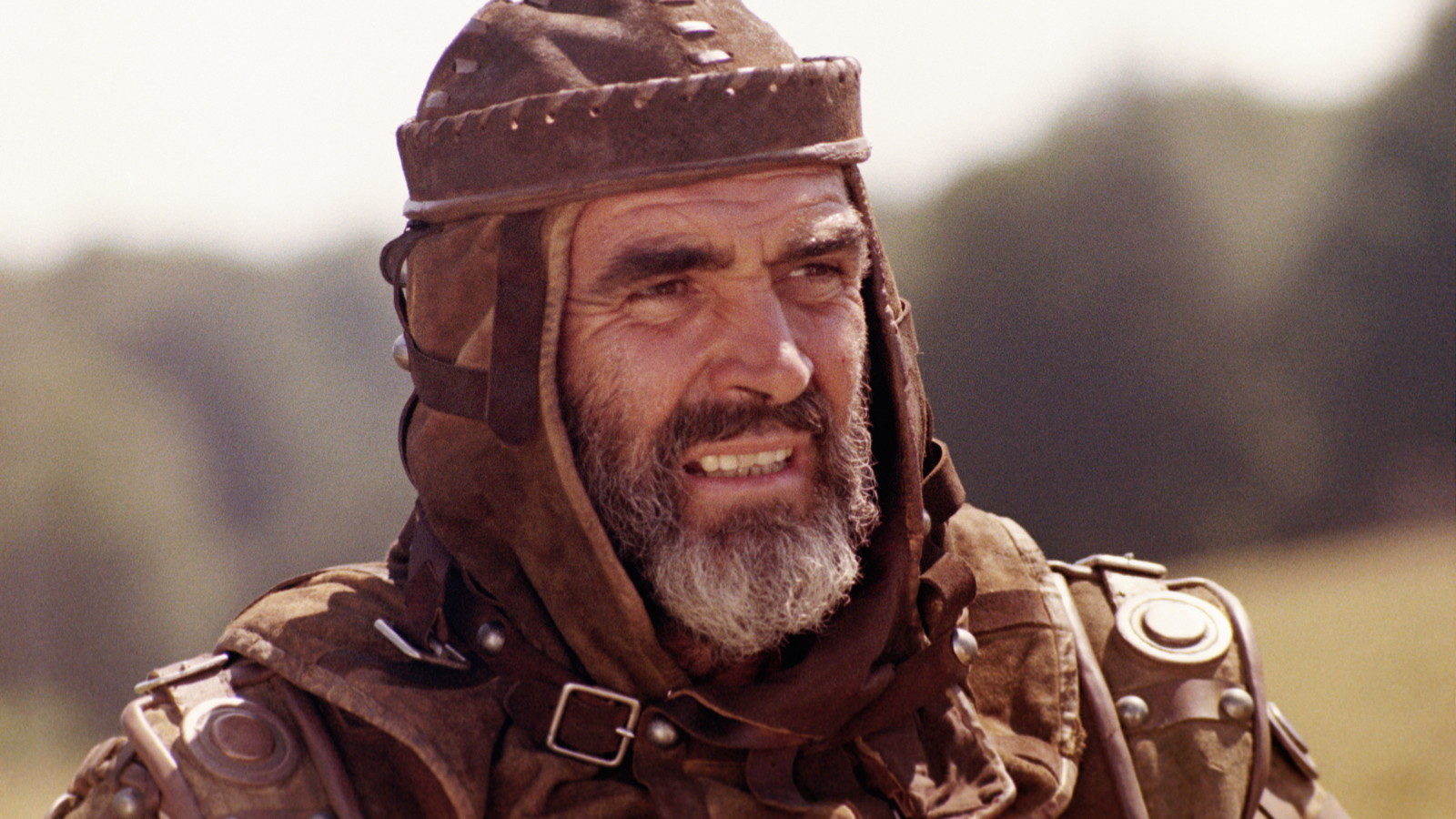
In recent years there has been a noticeable dearth of sword-fights in films. This particular form of choreographed action is most indelibly associated with the swashbuckler, romantic action-adventures whose heyday was Classical Hollywood. Back then, audiences loved them for their speed, vitality, and dazzling visuals. Studios loved them because you could be as freely creative with history as you liked under the banner of escapism. Yet, far from being timeless, a unique quality of the swashbuckler has always been its persistent out-of-dateness, its formula of courtly love, elegant or balletic action scenes, and the idealistic simplification of politics, often viewed as sappy. However, the romantic charm of swashbucklers is not necessarily restricted to historical films, being something closer to an aesthetic, one that combines lusty optimism with the piquancy of style-over-substance, or what used to be described, nebulously, as ‘high spirits’. Perhaps one reason the genre seems to have been permanently out of fashion since the silent era is fairly few films have got the combination right.
The archetypal swashbuckling hero is a blithe, breezy idealist with no time for moody self-examination, and generally no need to discover that they are a ‘chosen one’ because they probably believed it already. Such characters owe their irascible swagger to the likes of Robin Hood, D’Artagnan, Zorro and the Scarlet Pimpernel, all dashing young men of noble birth who appoint themselves defenders of the established order against usurpers. This represents another, early quality of swashbucklers, the celebration of aristocratic entitlement, dressed up with pomp and ceremony. Classical Hollywood always featured some incarnation of this romantic daredevil. In the 20s it was the beaming, acrobatic Douglas Fairbanks. In the prewar years there was the stiff-upper lip gallantry of Leslie Howard and Ronald Colman, followed by the youthful insouciance of matinee idols such as Errol Flynn, Tyrone Power and Douglas Fairbanks Jr, bounding through the story with all the confidence of someone who knows, just as the audience did, that between the beginning and end, they are indestructible.
By the 50s, the swashbuckler’s costumed frippery was beginning to be seen as a joke, parodied in films like Singin’ in the Rain (1952) and The Court Jester (1955). Thirty years later, directors of the New Hollywood era like Richard Donner, Steven Spielberg and George Lucas, created the modern blockbuster, in part, by romanticising their own childhood memories of swashbucklers, whose optimism was often reflected in sci-fi and fantasy films, if not always their romance. Around this time, the genre’s ghost was belatedly laid to rest by The Princess Bride (1987).
The swashbuckling hero had evolved, however, and arguably found its 80’s equivalent in the wisecracking hypermasculinity of action movie stars like Stallone and Schwarzenegger. This may seem ironic given that swashbuckling, even at its height, was seen as slightly effete, but although the colourful romance was missing, its myth of a heroism that could singlehandedly right the world’s wrongs remained intact, and also looks just as camp now as classic swashbucklers did to postwar audiences.
In later years, despite the best efforts of handsome, historical romances like Rob Roy (1995), The Mask of Zorro (1998) and Master and Commander: The Far Side of the World (2003), sword-fighting remains fairly moribund in movies, whilst the occasional, mammoth success of a blockbuster like Pirates of the Caribbean: The Curse of the Black Pearl (2003), if anything, seems to have encouraged its demise.
At their best, swashbucklers gave viewers the guiltlessly kitschy pleasure of excursions into ahistorical, hyperreal worlds of darknessless. Here are ten that managed it best:
1. The Prisoner of Zenda (1937)
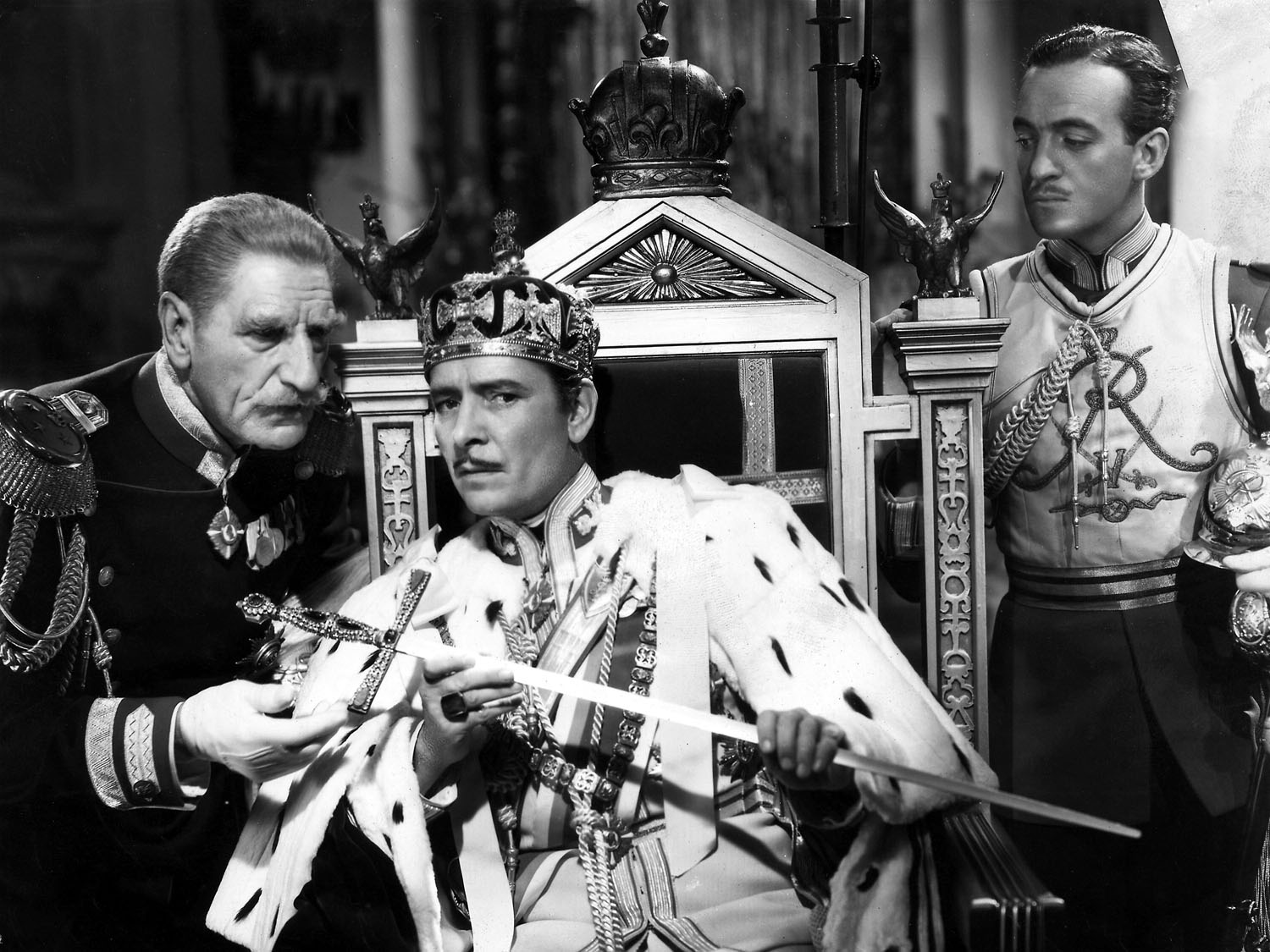
One of the swashbuckler’s most familiar early tropes, established in nineteenth century literature, was the romanticisation of patriotism, reflecting contemporary anxieties about the collapse of empire. Such ideas are explored in Anthony Hope’s 1894 bestseller The Prisoner of Zenda, adapted three times during the silent era, but most famously filmed by David O. Selznick in 1937.
Rudolf Rassendyll (Ronald Colman) is an English gentleman on a fishing holiday in Ruritania, where he conveniently meets his doppelgänger, Prince Rudolf, who also happens to be his cousin. Rassendyll agrees to impersonate Rudolf at his coronation in order to protect him from a scheming half-brother (Raymond Massey) and his venal accomplice Rupert (Douglas Fairbanks Jr). Matters are complicated when Rudolf is kidnapped and Rassendyll falls in love with his fiancée, Princess Flavia (Madeleine Carroll).
Although faded now, this film’s success cast a long shadow. It was popular enough to get a shot-for-shot, colour remake in 1952, and has also been parodied in everything from Blake Edwards’ The Great Race (1965) to Richard Lester’s Royal Flash (1975), and Ivan Reitman’s Dave (1993), with a spoof version starring Peter Sellers in 1979.
Like many of its European contemporaries set in fictional countries, including Hitchcock’s similarly romantic thriller The Lady Vanishes (1938) or Geoffrey Household’s novel Rogue Male (1938), the film celebrates English ‘public school values’ in the face of real-world political upheavals. During their famous climactic duel, Rupert mocks Rassendyll’s Old Etonian sense of duty, positioning himself as a dangerous, youthful iconoclast (that he is also dressed like a fascist blackshirt may be coincidental). The film’s prologue sets the scene at a time, “when History still wore a Rose, and Politics had not yet outgrown the Waltz”. To contemporary eyes this seems to be asking the audience to suspend its disbelief, but with its slightly preachy, patrician sensibility, it is hard to tell just how seriously the film took itself.
2. The Adventures of Robin Hood (1938)
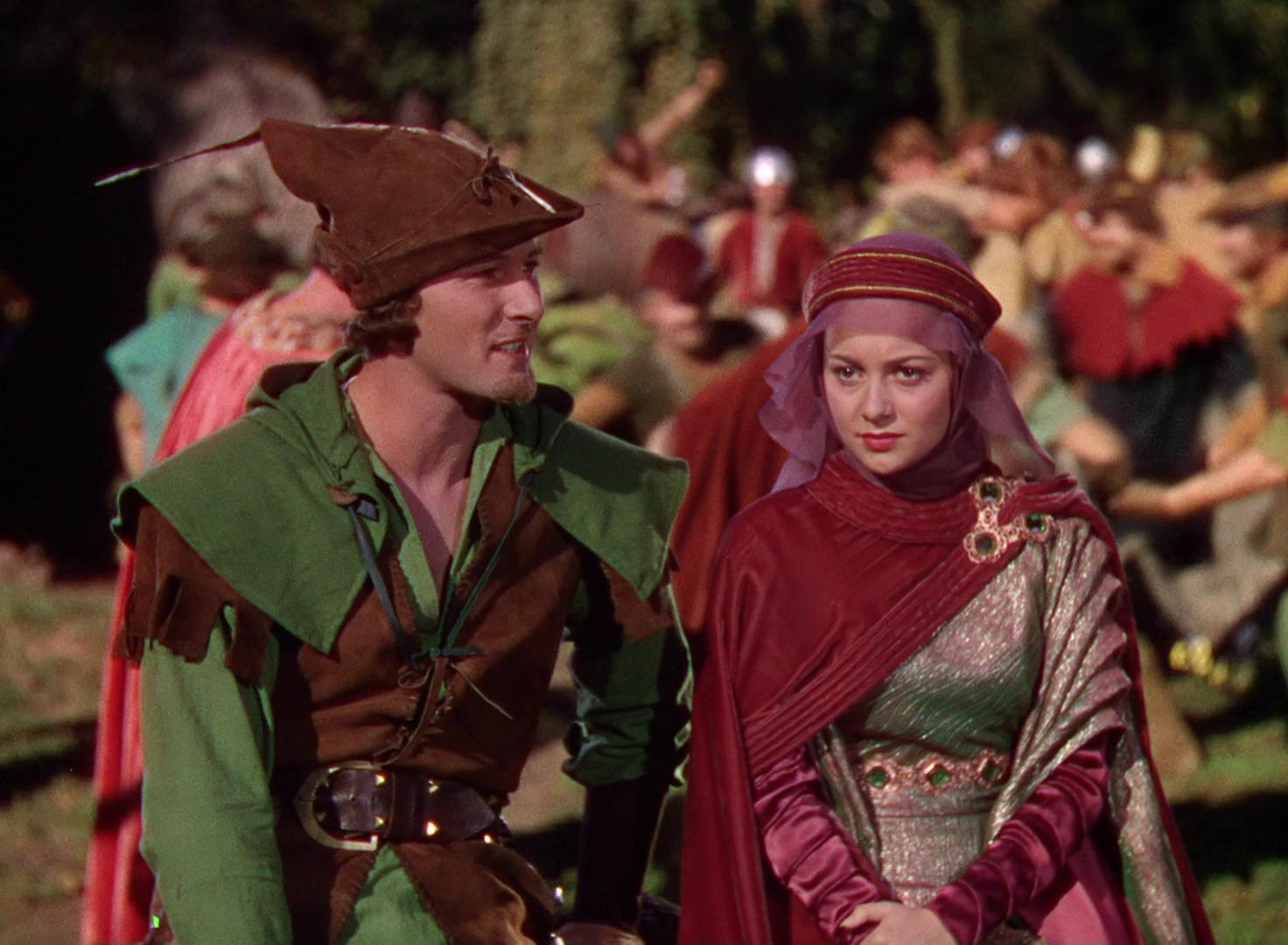
Released just as WWII was about to begin, The Adventures of Robin Hood (1938) may be the best swashbuckling film ever made. Warner Bros. reassembled the key creative personnel of their earlier action-adventure Captain Blood (1935), and it is remarkable just how primitive that film looks by comparison.
Set in a joyfully anachronistic version of medieval England, the story opens with ‘King Richard the Lionheart’ missing, later presumed dead. Meanwhile, in Nottingham, Sir Robin of Locksley (Errol Flynn) leads a band of Saxon rebels against the oppressive Norman regime of pretender Prince John (Claude Rains), and his heavy Sir Guy of Gisbourne (Basil Rathbone). After an episodic game of cat-and-mouse, during which Robin woos the king’s ward Lady Marian (Olivia de Havilland) from below her balcony, Richard miraculously reappears and order is cleanly restored.
One of the first Hollywood epics in sparkling Technicolor, the film makes its romantic formula appear effortless, which may be why it was so difficult to replicate. With multiple directors and writers, it could only have been achieved by happy accident, very few films having succeeded in matching its energy. The heroes fight with miniaturised broadswords and smile during the final battle as if walking on water; King Richard wears chainmail armour in every scene, and yet, somehow, the prelapsarian confidence never frays. The giant, impractical sets and California countryside, together with Erich Wolfgang Korngold’s Oscar-winning score, create an atmosphere not so much stylised as fantastical, whilst Flynn’s infectious exuberance makes him perhaps the one convincingly ‘merry’ screen version of Robin Hood, and a reminder how much more likeable he reportedly was onscreen than behind-the-scenes.
This is the kind of early colour film so rich, you could imagine the negative was several inches thick and tasted like red velvet meringue. Just as it appeared in its day as an unabashedly romanticised dream of history and warfare, it now looks like the romantic dream of a Hollywood cinema that (almost) never was.
3. The Sea Hawk (1940)
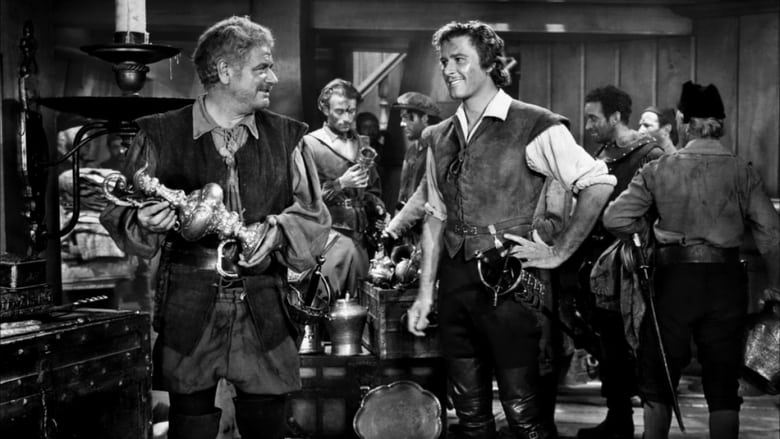
Following Robin Hood, Warner planned to put Errol Flynn in an adaptation of Don Juan, but the outbreak of war in Europe prompted them to instead do The Sea Hawk (1940), essentially a remake of the British historical drama Fire Over England (1937) on a bigger budget.
The almost entirely fictional story sees 17th-century privateer Geoffrey Thorpe (Flynn) dispatched by Elizabeth I (Flora Robson) to South America on a mission to sabotage Spain’s shipping fleet. After being captured thanks to high-placed spies in the English court, Thorpe and his crew escape in time to bring back news of Philip II’s secret invasion plans.
As in Fire Over England, Spain acts as a proxy for Nazi Germany, replacing a pro-interventionist message with an anti-isolationist one. It even gets delivered by the same actor, as Flora Robson played the queen in both. Part of the pleasure of swashbucklers comes from the circumscription of their stories within an hermetically-sealed world of heroic idealism. Here, a political allegory is combined with an escapist formula by applying a literal layer of gritty realism to the pageantry, the ‘dark’ scenes set in Panama being sepia-tinted (the rest is in black-and-white). Inevitably, real-world concerns tend to leave the wilful innocence looking dainty, and wartime audiences would soon lost interest in lavish swashbucklers.
Warner eventually made The Adventures of Don Juan in 1948. Although it failed at the box office, it is still an enjoyable return to the genre’s Technicolor glory days, even if Flynn’s alcoholism had started to show.
4. The Mark of Zorro (1940)
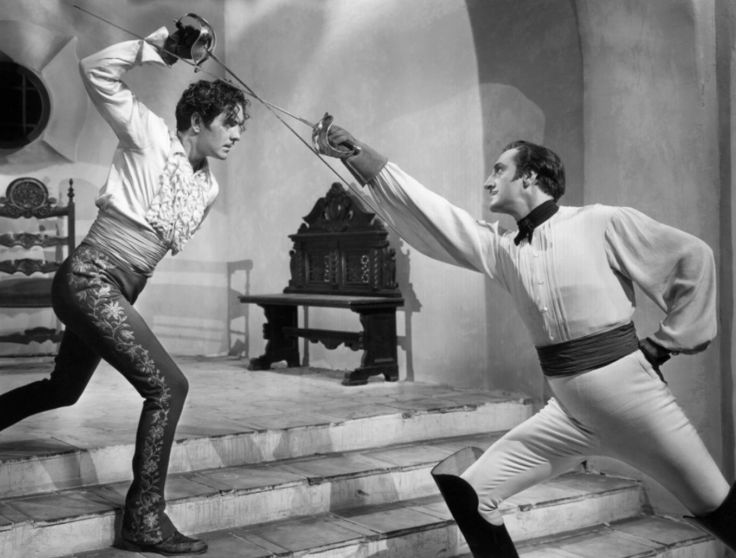
In the early 1800s, Diego de la Vega (Tyrone Power) returns to California from Spain to find his father’s former district being fleeced for gold by its corrupt new governor and his captain of the guard (Basil Rathbone). Springing into action, Diego starts acting the fop by day in order to play Zorro by night, whilst courting advances from the governor’s daughter (Linda Darnell) and wife (Gale Sondergaard). He quickly rouses the people to rebellion, restoring his father to power.
Directed by Rouben Mamoulian, The Mark of Zorro (1940) may be best remembered now as the film Bruce Wayne is supposed to have seen before his parents’ murder, but of all the classic swashbucklers, it is possibly the most fun. Produced by Twentieth Century Fox on a smaller scale than its more operatic Warner rivals, it benefits from cartoonishly fast pacing and a looser attitude to romance. The witty, cavalier Power is impossible not to like, even if his Diego seems to be doing little more than amusing himself from beginning to end. It also contains perhaps the finest sword-fight in all of classical Hollywood, dispensing with expressionistic shadows and rousing music in favour of polish and precision, for once giving Rathbone the defeat he deserved.
Keen to avoid typecasting, Power mostly avoided swashbucklers thereafter. The best of his later forays is Son of Fury: The Son of Benjamin Blake (1941), which made the innovation of replacing swords with boxing. This works well though it failed to set any trends.
5. Buccaneer’s Girl (1950)
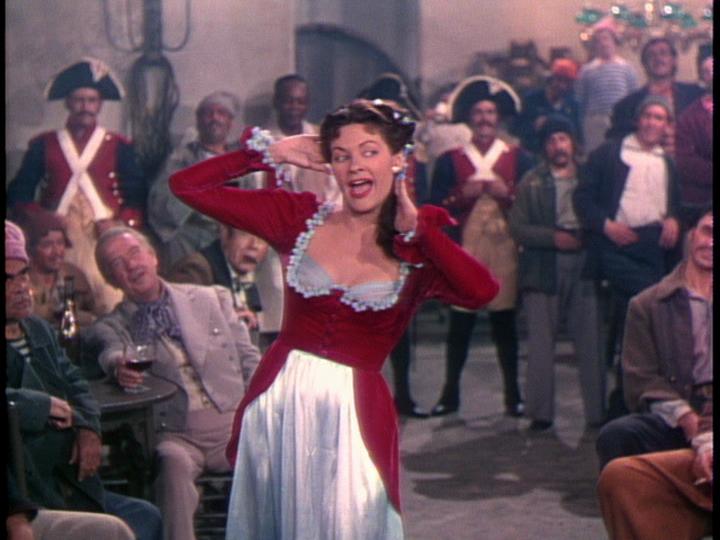
Compared with most other genres in Classical Hollywood, swashbucklers were less restrictive when it came to reinforcing gender norms. From the mid-40s, audiences could particularly expect to see female protagonists in pirate-themed films. From Binnie Barnes in The Spanish Main (1945) to Jean Arthur as Anne of the Indies (1951) and Rhonda Flemyng in The Golden Hawk (1952), swashbucklers were the place women were most likely to be found in action-oriented roles. Maureen O’Hara even became a swashbuckling star herself after playing Athos’ daughter in Sons of the Musketeers (1952), before appearing as a pirate opposite Errol Flynn in Against All Flags (1952). Although more of a screwball comedy with music than a true swashbuckler, Buccaneer’s Girl (1950) is one of the genre’s most satisfying piratical adventures.
Yvonne de Carlo plays Bostonian singer Deborah McCoy, who stows away aboard a ship bound for New Orleans, meeting notorious pirate Baptiste (Philip Friend) along the way. Upon reaching her destination, she discovers Baptiste is leading a double-life as the world’s top pirate catcher in order to dupe a local, crooked businessman (Robert Douglas). Events lead to her joining his crew and becoming a pirate herself.
Directed by Fred de Cordova, the film was one of several produced during the ‘Red Scare’ – along with Jacques Tourneur’s The Flame and the Arrow (1950) and Robert Siodmak’s The Crimson Pirate (1952) – that playfully snuck anti-imperialist subversion into swashbucklers. It is also gorgeously colourful, with a supporting cast including genre veteran Henry Daniell and the great Elsa Lanchester, whilst Robert Douglas is one of cinema’s most overlooked moustache-twirling villains.